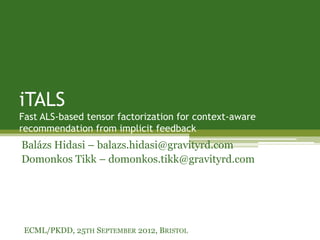iTALS: implicit tensor factorization for context-aware recommendations (ECML/PKDD 2012 presentation)
- 1. iTALS Fast ALS-based tensor factorization for context-aware recommendation from implicit feedback Bal├Īzs Hidasi ŌĆō balazs.hidasi@gravityrd.com Domonkos Tikk ŌĆō domonkos.tikk@gravityrd.com ECML/PKDD, 25TH SEPTEMBER 2012, BRISTOL
- 2. Overview ŌĆó Implicit feedback problem ŌĆó Context-awareness Ō¢½ Seasonality Ō¢½ Sequentaility ŌĆó iTALS Ō¢½ Model Ō¢½ Learning Ō¢½ Prediction ŌĆó Experiments
- 3. Feedback types ŌĆó Feedback: user-item interraction (events) ŌĆó Explicit: Ō¢½ Preferences explicitely coded Ō¢½ E.g.: Ratings ŌĆó Implicit: Ō¢½ Preferences not coded explicitely Ō¢½ E.g.: purchase history
- 4. Problems with implicit feedback ŌĆó Noisy positive preferences Ō¢½ E.g.: bought & disappointed ŌĆó No negative feedback available Ō¢½ E.g.: had no info on item ŌĆó Usually evaluated by ranking metrics Ō¢½ Can not be directly optimized
- 5. Why to use implicit feedback? ŌĆó Every user provides ŌĆó Some magnitudes larger amount of information than explicit feedback ŌĆó More important in practice Ō¢½ Explicit algorithms are for the biggest only
- 6. Context-awareness ŌĆó Context: any information associated with events ŌĆó Context state: a possible value of the context dimension ŌĆó Context-awareness Ō¢½ Usage of context information Ō¢½ Incorporating additional informations into the method Ō¢½ Different predictions for same user given different context states Ō¢½ Can greatly outperform context-unaware methods ’é¢ Context segmentates items/users well
- 7. Seasonality as context ŌĆó Season: a time period Ō¢½ E.g.: a week ŌĆó Timeband: given interval in season Ō¢½ Context-states Ō¢½ E.g.: days ŌĆó Assumed: Ō¢½ aggregated behaviour in a given timeband is similar inbetween seasons User Item Date Context Ō¢½ and different for different 1 A 12/07/2010 1 timebands 2 B 15/07/2010 3 Ō¢½ E.g.: daily/weekly routines 1 B 15/07/2010 3 ŌĆ” ŌĆ” ŌĆ” 1 A 19/07/2010 1
- 8. Sequentiality ŌĆó Bought A after B Ō¢½ B is the context-state of the userŌĆÖs event on A ŌĆó Usefullness Ō¢½ Some items are bought together Ō¢½ Some items bought repetetively Ō¢½ Some are not ŌĆó Association rule like information incorporated into model as context Ō¢½ Here: into factorization methods ŌĆó Can learn negated rules Ō¢½ If C then not A
- 9. M3 iTALS - Model ŌĆó Binary tensor Ō¢½ D dimensional User Ō¢½ User ŌĆō item ŌĆō context(s) M1 T ŌĆó Importance weights Ō¢½ Lower weights to zeroes (NIF) Ō¢½ Higher weights to cells with Item more events M2 ŌĆó Cells approximated by sum of the values in the elementwise product of D vectors Ō¢½ Each for a dimension Ō¢½ Low dimensional vectors
- 11. iTALS - Prediction ŌĆó Sum of values in elementwise product of vectors Ō¢½ User-item: scalar product of feature vectors Ō¢½ User-item-context: weighted scalar product of feature vectors ŌĆó Context-state dependent reweighting of features ŌĆó E.g.: Ō¢½ Third feature = horror movie Ō¢½ Context state1 = Friday night ’āĀ third feature high Ō¢½ Context state2 = Sunday afternoon ’āĀ third feature low
- 12. Experiments ŌĆó 5 databases Ō¢½ 3 implicit ’é¢ Online grocery shopping ’é¢ VoD consumption ’é¢ Music listening habits Ō¢½ 2 implicitizied explicit ’é¢ Netflix ’é¢ MovieLens 10M ŌĆó Recall@20 as primary evaluation metric ŌĆó Baseline: context-unaware method in every context- state
- 13. Scalability Running times on the Grocery dataset 350 300 iALS epoch Running time (sec) 250 iTALS (time bands) epoch 200 iTALS (sequence) epoch 150 iALS calc. matrix 100 iTALS (time bands) calc. matrix 50 iTALS (sequence) calc. matrix 0 10 20 30 40 50 60 70 80 90 100 Number of factors (K)
- 14. Results ŌĆō Recall@20 0.1200 0.1000 0.0800 0.0600 0.0400 0.0200 0.0000 VoD Grocery LastFM Netflix MovieLens iALS (MF method) iCA baseline iTALS (seasonality) iTALS (sequence)
- 15. Results ŌĆō Precision-recall curves 0.25 Recall-precision (Grocery) 0.20 0.15 0.10 iALS 0.05 0.00 iCA baseline 0.00 0.05 0.10 0.15 0.20 Recall-precision (VoD) iTALS 0.08 (season) 0.06 iTALS (sequence) 0.04 0.02 0.00 0.00 0.05 0.10 0.15 0.20
- 16. Summary ŌĆó iTALS is a Ō¢½ scalable Ō¢½ context-aware Ō¢½ factorization method Ō¢½ on implicit feedback data ŌĆó The problem is modelled Ō¢½ by approximating the values of a binary tensor Ō¢½ with elementwise product of short vectors Ō¢½ using importance weighting ŌĆó Learning can be efficiently done by using Ō¢½ ALS Ō¢½ and other computation time reducing tricks ŌĆó Recommendation accuracy is significantly better than iCA-baseline ŌĆó Introduced a new context type: sequentiality Ō¢½ association rule like information in factorization framework
- 17. Thank you for your attention! For more of my recommender systems related research visit my website: http://www.hidasi.eu T

















